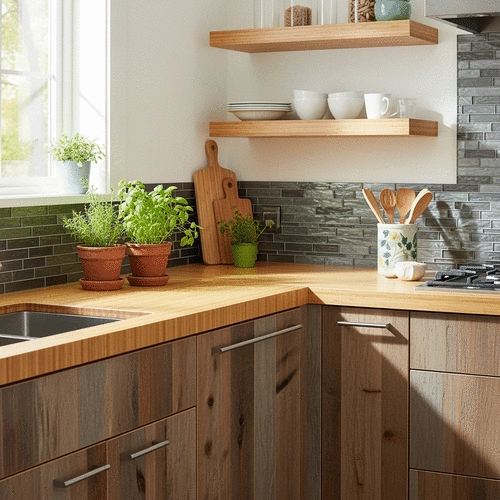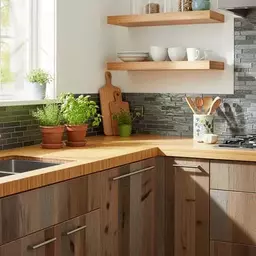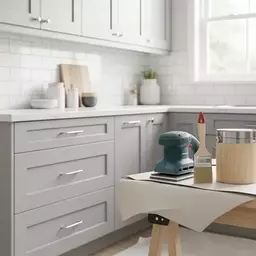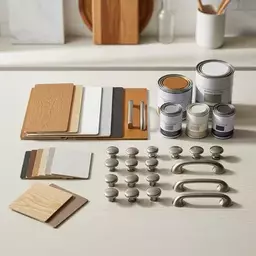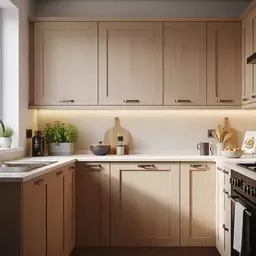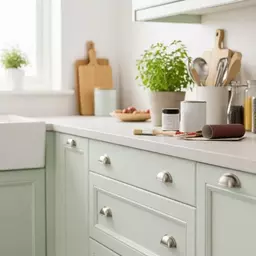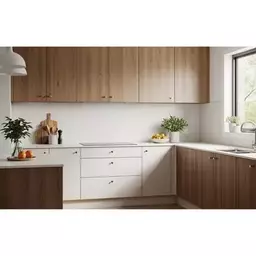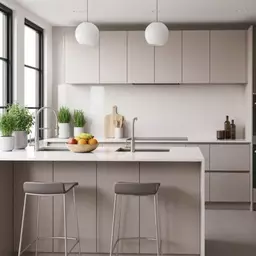Did you know that making sustainable choices in your kitchen can significantly reduce your carbon footprint while enhancing the beauty of your home? By selecting eco-friendly materials and methods, you can create a stunning kitchen that reflects your values and contributes positively to the planet. Let's explore the essential lessons from the world of sustainable kitchen refacing!
What You Will Learn
- Sustainable Options: Discover key materials like bamboo, reclaimed wood, and recycled products that minimize environmental impact while maximizing style.
- Environmental Benefits: Understand how sustainable materials can reduce deforestation, waste, and overall carbon emissions in your kitchen renovations.
- Value Addition: Learn how eco-friendly kitchens can enhance your home's appeal and potentially increase its market value.
- Maintenance Tips: Get practical advice on how to care for sustainable materials to ensure longevity and beauty in your kitchen.
Environmental Impact of Kitchen Refacing Materials
Discover the benefits of choosing sustainable materials in your kitchen renovations, focusing on their environmental footprint.
Reduced Deforestation
Sustainable materials often come from responsibly managed forests, helping to preserve natural habitats.
Less Waste
Reclaimed and recycled materials keep waste out of landfills, contributing to a cleaner environment.
Lower Emissions
Eco-friendly materials typically have a smaller carbon footprint compared to traditional options.
Health Benefits
Many sustainable materials have low or no harmful chemicals, promoting a healthier living space.
Understanding Sustainable Kitchen Refacing Materials
As a passionate advocate for sustainable living, I believe that the kitchen should not only be functional but also friendly to our planet. When it comes to kitchen refacing, choosing sustainable materials is a fantastic way to upgrade your space while reducing environmental impact. These materials not only help in minimizing waste but also provide an opportunity to create beautiful and stylish kitchens that align with eco-conscious values. For more ideas on how to achieve this, explore eco-friendly kitchen refacing materials.
At Kitchen Refacing Guide, we focus on empowering homeowners with insights about how to make selections that are both aesthetically pleasing and sustainable. So, let's dive deeper into the world of sustainable options in cabinet refacing and discover why these choices matter!
Defining Sustainable Options in Cabinet Refacing
Sustainable options in cabinet refacing refer to materials and methods that minimize harm to the environment while maximizing durability and aesthetic appeal. Here are some key examples:
- Bamboo: A renewable resource that grows quickly and sustainably.
- Reclaimed wood: Wood salvaged from old buildings, offering unique character.
- Recycled materials: Products that are crafted from recycled substances, reducing waste.
By choosing these options, we can ensure our kitchen renovations leave a lighter footprint on the earth. Isn't it exciting to think that every decision can contribute to a more sustainable future?
Why Sustainability Matters in Kitchen Renovations
Embracing sustainability in kitchen renovations is crucial for numerous reasons. Firstly, it helps reduce our carbon footprint and conserve natural resources. By opting for sustainable materials, we are actively participating in a movement that prioritizes our environment.
Additionally, sustainable kitchens can also enhance your home's value and appeal. When potential buyers see a kitchen that features eco-friendly materials, it signals that the home is well-cared for and updated. This can result in higher offers down the line! To learn more about common materials used in Australia, check out our guide on cabinet refacing materials in Australia.
- Environmental impact: Conserves resources and reduces waste.
- Health benefits: Many sustainable materials have low or no harmful chemicals.
- Increased home value: Sustainable features can make your kitchen more appealing to buyers.
Ultimately, making sustainable choices in your kitchen refacing journey is not just about style; it's about making a positive impact. Are you ready to explore these exciting options for your own kitchen transformation?
Quick Summary
Here's a brief recap of the key points discussed so far:
- Sustainable materials: Options like bamboo, reclaimed wood, and recycled materials minimize environmental harm.
- Importance of sustainability: Eco-friendly choices enhance home value, reduce carbon footprint, and promote health benefits.
- Lifecycle analysis: Understanding the carbon footprint of materials aids in making informed decisions for kitchen renovations.
Environmental Impact of Kitchen Refacing Materials
When we think about transforming our kitchens, it’s important to consider the environmental impact of the materials we choose. In the world of cabinet refacing, understanding the lifecycle and carbon footprint of different options is a crucial step toward making eco-friendly choices. By opting for sustainable materials, not only can we enhance the beauty of our homes, but we can also help protect our planet!
A lifecycle analysis provides insights into how different materials impact the environment from production to disposal. This analysis can help you understand which materials are less harmful and which ones can contribute positively to our ecosystem. Are you curious about the environmental footprint of your kitchen refacing project? Let’s dive deeper!
Lifecycle Analysis: Carbon Footprint of Various Options
When assessing the carbon footprint of cabinet refacing materials, consider these key factors:
- Production energy: The amount of energy used in creating the materials.
- Transportation impact: Emissions generated during the shipping of materials to your location.
- Disposal methods: How the materials are handled at the end of their life cycle.
For example, using reclaimed wood not only reduces the need for new trees but also minimizes the emissions related to the manufacturing process. Each choice you make, from bamboo cabinets to low-VOC finishes, can significantly influence your kitchen's overall carbon footprint.
Comparative Environmental Benefits of Sustainable Materials
Choosing sustainable materials for your kitchen refacing project brings numerous benefits that go beyond aesthetics. Here are some of the environmental advantages:
- Reduced deforestation: Sustainable materials often come from responsibly managed forests.
- Less waste: Reclaimed and recycled materials keep waste out of landfills.
- Lower emissions: Eco-friendly materials typically have a smaller carbon footprint compared to traditional options.
As a passionate advocate for sustainability through my blog, Kitchen Refacing Guide, I can assure you that making these choices not only helps the planet but also adds character to your home. Each piece of sustainable material carries a story, contributing to a unique kitchen that reflects your values!
Practical Sourcing and Installation Guidance
Finding the right materials is just the first step; knowing where to look can make all the difference in your kitchen refacing journey. Connecting with local suppliers who specialize in sustainable options helps not only your project but also the community. Plus, it often leads to discovering unique finds that can set your kitchen apart!
Let’s explore how to source sustainable materials effectively. With a bit of research, you can find options that suit your style and budget!
Finding Local Suppliers of Sustainable Materials
Here are some tips to help you locate local suppliers:
- Research online: Use search engines to find local eco-friendly suppliers in your area.
- Visit home improvement stores: Many stores now have dedicated sections for sustainable materials.
- Ask for recommendations: Talk to friends or local contractors who have experience with sustainable projects.
By connecting with local suppliers, you're supporting businesses that share your commitment to sustainability. Plus, you’ll likely find materials that fit your vision perfectly!
Installation Challenges: What to Expect
While cabinet refacing is often a manageable DIY project, understanding the challenges can help you prepare better. Here are some common installation challenges:
- Surface preparation: Ensuring surfaces are clean and smooth is crucial for proper adhesion.
- Material compatibility: Some materials may require specific adhesives or techniques for installation.
- Time commitment: Depending on the scope of your project, refacing can take longer than you might expect!
But don’t worry! With a bit of planning and the right materials, these challenges can be overcome. Remember, taking the time to do it right will pay off in the long run! For techniques and tips, consider exploring cabinet resurfacing techniques explained.
Frequently Asked Questions About Sustainable Kitchen Refacing
- What are sustainable kitchen refacing materials?
- Sustainable kitchen refacing materials are eco-friendly options like bamboo, reclaimed wood, and recycled products that minimize environmental harm, reduce waste, and have a smaller carbon footprint.
- How do sustainable materials benefit the environment?
- They help reduce deforestation by using responsibly managed resources, decrease landfill waste by utilizing reclaimed and recycled items, and lower carbon emissions compared to traditional materials.
- Can sustainable kitchen refacing increase my home's value?
- Yes, incorporating eco-friendly materials and designs can enhance your home's appeal and potentially increase its market value, as buyers often appreciate sustainable features.
- What are some common installation challenges for sustainable refacing materials?
- Challenges can include ensuring proper surface preparation, understanding material compatibility for adhesives and techniques, and allocating sufficient time for the project.
- How should I care for sustainable cabinets to ensure longevity?
- Maintenance varies by material: bamboo requires cleaning with a damp cloth, reclaimed wood benefits from periodic conditioning, and plywood/MDF should be kept free of moisture. Regular cleaning and hardware checks are generally recommended.
Maintenance Tips for Sustainable Cabinets
Once your eco-friendly kitchen is complete, it's important to keep it looking great! Sustainable materials often come with unique maintenance needs. I want to share some tips that will help you care for your cabinets, keeping them vibrant and durable.
Regular maintenance not only prolongs the lifespan of your cabinets but also ensures they stay functional and beautiful.
Caring for Different Materials for Longevity
Different materials require different care. Here are some guidelines:
- Bamboo: Clean with a damp cloth and avoid harsh chemicals to prevent damage.
- Reclaimed wood: Use a wood conditioner periodically to maintain its natural beauty.
- Plywood and MDF: Keep surfaces free of moisture to prevent warping or swelling.
By following these simple care tips, you’ll be well on your way to enjoying your sustainable cabinets for years to come!
Protecting Your Investment: Routine Maintenance Practices
In addition to material-specific care, here are some general routine maintenance practices:
- Regular cleaning: Wipe down cabinets with a soft, damp cloth weekly.
- Check hinges and hardware: Tighten screws and lubricate moving parts to ensure smooth operation.
- Monitor for damage: Keep an eye out for any signs of wear or issues, addressing them promptly.
Taking the time to regularly maintain your cabinets protects your investment and enhances your kitchen's overall look!
Engaging with Sustainable Options: Final Thoughts
As you embark on your kitchen refacing journey, I encourage you to embrace sustainable materials that reflect your personal style and values. Not only do these choices benefit you, but they also contribute positively to our environment. If you're looking for expert insights or specific advice tailored to your kitchen needs, don't hesitate to reach out!
Whether it's through Kitchen Refacing Guide or other resources, there’s a wealth of information available to help you make informed decisions. Together, we can create beautiful, eco-friendly kitchens that make a statement!
Consultation Offers for Eco-Friendly Kitchen Renovations
Are you ready to transform your kitchen sustainably? I offer consultations to guide you through the process and help you select materials that align with your eco-friendly vision. Let’s work together to create a kitchen you’ll love!
Further Resources for Sustainable Design Inspiration
For additional ideas and inspiration, check out these resources:
- Online forums: Join communities focused on sustainable design to share experiences.
- Design blogs: Follow blogs like Kitchen Refacing Guide for tips and inspiration.
- Eco-friendly magazines: Browse publications dedicated to sustainable living for fresh ideas.
Feeling inspired? I can't wait to see how you apply these sustainable choices to your kitchen transformation! For more ideas on how to achieve a stylish and sustainable kitchen, explore stylish kitchen refacing ideas in Australia.
Recap of Key Points
Here is a quick recap of the important points discussed in the article:
- Sustainable Materials: Consider options like bamboo, reclaimed wood, and recycled materials to minimize environmental impact while enhancing aesthetic appeal.
- Environmental Benefits: Using sustainable materials reduces deforestation, minimizes waste, and lowers carbon emissions, contributing to a healthier planet.
- Local Sourcing: Support your community by sourcing sustainable materials from local suppliers, which can also lead to unique finds for your kitchen.
- Installation Awareness: Be prepared for challenges during installation, such as surface preparation and material compatibility, to ensure a successful project.
- Maintenance Practices: Regular care tailored to specific materials, such as cleaning and monitoring for damage, will prolong the lifespan of your sustainable cabinets.
- Engagement and Resources: Embrace sustainable options that reflect your values and seek out resources for further inspiration and expert advice.

